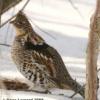DEC Proposes No Grouse/wc/hare Management for Tug Hill WMA -- Hunter Comments Needed by Dec 20!
-
Similar Content
-
By BuckSteady
New hunter to NY here. Found some public land to hunt, it’s a WMA. I wish I read the regs more thoroughly because I threw up a ladder stand yesterday and today when I was re-reading them, I saw you can’t put temporary stands on WMAs, only on state forests and other such state land. I honestly didn’t know I wasn’t allowed to, I even put my name and license # on the stand. I was going to go take it down tomorrow but it’s an hour drive so I wanted to ask, what do DEC officers do if they find a ladderstand like mine on a WMA? Is this an automatic fine or whatever? Will they just call me and tell me to come get it? Confiscate? How often do officers go through areas like WMAs and check for stands? Any info would be helpful. I’ll still probably go take it down tomorrow, although I have seen other stands up on the WMA, I just prefer to stay on the right side of the law myself. Thanks!
-
By CapDistPatriot
Southern Zone only. I don't understand why they don't include rifle, only Bow & Muzzy...
https://www.dec.ny.gov/press/121333.html
-
By ltnic
We're happy to offer a hunting parcel of 72+ acres on our 169.35 acre farm for you to hunt our many whitetail deer, turkeys, grouse and small game. The farm is a paradise for deer with over 300 wild apple trees throughout the property, open meadows, hay fields, deep timber and water in multiple places. We're only a ~3 hour drive from NYC making us a great weekend hunting getaway in a beautiful & serene setting. This is the eastern half of our farm. We're located 8 miles from Norwich and 18 miles from Oneonta where you can seek lodging, restaurants and shopping. Our 4 bedroom, 4 bath house, nice post and beam barn and 169.35 acres are available for sportsman interested in purchasing property.
You can book your hunt on our property through our LandTrust profile here: https://www.landtrust.com/l/grassmere-farm-east/5d92408a-f38c-4f64-98c3-97251a8b626f
-
By Padre86
Anyone here ever tried calling for black bear in the northern zone of NY (mostly referring to Tug Hill and the ADK's)?
I've heard that in certain areas which have similar vegetation and terrain to NY (western Oregon and Washington) calling black bear is a tactic used by some hunters, as traditional spot-and-stalk hunts aren't really feasible and baiting and hounding aren't allowed.
I was thinking of trying some calling this coming fall. I'd be interested in talking to anyone else who has tried this method.
-
By Gunner
I thought I'd share a little story and pics from a late Feb. 2018 Hare hunting trip to northern NY. I live in S. central PA ; and it's a 5 +hr. drive. I arrived on a sat. at 11am and not familiar with the area ; but a friend gave me a few spots to hunt. I hunted with 2 beagles age 11 & 13 yrs... They still hunt like fools ! We hunted a spot for 3 hrs. with a couple slow runs . Plenty of Hare tracks but no sight of any Hare. I decided to try across the road from where I parked . I walked the edge of a swamp and with 3-4 feet of snow my snowshoes were fine until....I stepped down into a frozen waterhole and broke through. I extracted myself from the knee deep water and headed to my truck . Numb feet by the time I walked the 650 yds. and it's 3pm. No extra boots so.. Day over . . Day 2 arrived with 4 in. fresh snow ; and my friend with his 3 younger beagles. We tried a spot I scouted before getting to the motel sat. night. We weren't in the woods 5 min. and my 13 yr old beagle opens on a fresh track. As the other dogs harked in it sounded like a screaming freight train of beagles ! In less than a minute they were outta hearing and at 400+ yds before the Hare turned and headed back our way. It evaded us 2 circles around; but the 3rd time my friend connects. The rest of the day was outstanding running ; with 9 Hare chases and 3 taken in Approx. 6 hrs. Here's a few pics. I will be back in the fall for sure.
-
-
Recently Browsing 0 members
No registered users viewing this page.






Recommended Posts
Join the conversation
You can post now and register later. If you have an account, sign in now to post with your account.